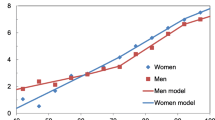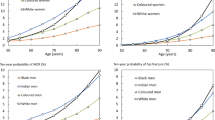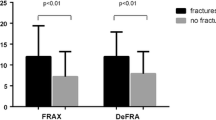Abstract
Osteoporosis is a generalized disease of bone that increases fracture risk. Multiple factors influence this risk, besides low bone mass. To decrease osteoporotic fractures, those patients who require preventive management should be readily identified. This paper aims to review current information on the use of the fracture risk assessment tool (FRAX™) in Latin America. Bone mineral density measurement is currently the method of reference for evaluating the fracture risk and opting for treatment; but, it misses a notable proportion of individuals who have clinical risk factors for osteoporosis and fractures. FRAX™ was designed to predict the 10-year absolute risk of sustaining a major osteoporotic fracture or a hip fracture. Although data is available for several countries, from Latin America, only Argentina appears in the current version of the tool. Its present use in other Latin American countries is possible with some adaptations based in similarities of epidemiological information of each country with some of the existing databases. The cutoff value beyond which treatment should be initiated needs to be determined, based not only on clinical criteria, but also on economic considerations.
Similar content being viewed by others
References
Morales-Torres J, Gutiérrez-Ureña S (2004) The burden of osteoporosis in Latin America. Osteoporos Int 15:625–632
World Population Prospects. The 2006 Revision Population Database. Available at: http://esa.un.org. Accessed on November 29, 2009
The World Bank. Available at: http://web.worldbank.org. Accessed on November 29, 2009
Clark P, Lavielle P, Franco-Marina F et al (2005) Incidence rates and life-time risk of hip fractures in Mexicans over 50 years of age: a population-based study. Osteoporos Int 16:2025–2030
Silveira VA, Medeiros MM, Coelho-Filho JM et al (2005) Hip fracture incidence in an urban area in Northeast Brazil Cad. Saude Publica 21:907–912
Castro da Rocha FA, Ribeiro AR (2003) Low incidence of hip fractures in an equatorial area. Osteoporos Int 14:496–499
Kanis JA, Johnell O, De Laet C et al (2002) International variations in hip fracture probabilities: implications for risk assessment. J Bone Miner Res 17:1237–1244
Morales-Torres J (2007) Strategies for the prevention and control of osteoporosis in developing countries. Clin Rheumatol 26:139–143
Global Industry Analists, Inc. Bone densitometers. A global strategic business report, August 2005. Available at: www.StrategyR.com. Accessed on: November 29, 2009
Morales-Torres J, López-García JA, Romero-Ibarra J, Camacho-Ochoa JI (2008) Cuánto cuesta tratar a mujeres con osteoporosis en México? Estimaciones acordes a diversos umbrales de intervención. Clin Rheumatol 4(supl. 1):38, abstract
Clark P, Carlos F, Barrera C et al (2008) Direct costs of osteoporosis and hip fracture. An analysis for the Mexican healthcare system. Osteoporos Int 19:269–276
Kanis JA, Burlet N, Cooper C et al (2008) European guidance for the diagnosis and management of osteoporosis in postmenopausal women. Osteoporos Int 19:399–428
Kanis JA (1994) Assessment of fracture risk and its application to screening for postmenopausal osteoporosis: synopsis of a WHO report. WHO Study Group. Osteoporos Int 4:368–381
Siris ES, Miller PD, Barrett-Connor E et al (2001) Identification and fracture outcomes of undiagnosed low bone mineral density in postmenopausal women: results from the National Osteoporosis Risk Assessment. JAMA 286:2815–2822
Marshall D, Johnell O, Wedel H (1996) Meta-analysis of how well measures of bone mineral density predict occurrence of osteoporotic fractures. BMJ 312:1254–1259
Cummings SR, Nevitt MC, Browner WS et al (1995) Risk Factors for hip fracture in white women. Study of Osteoporotic Fractures Research Group. N Engl J Med 332:767–773
Koh LK, Sedrine WB, Torralba TP et al (2001) A simple tool to identify Asian women at increased risk of osteoporosis. Osteoporos Int 12:699–705
Sen SS, Rives VP, Messina OD et al (2005) A risk assessment tool (OsteoRisk) for identifying Latin American women with osteoporosis. J Gen Intern Med 20:245–250
Cadarette SM, Jaglal SB, Kreiger N et al (2000) Development and validation of the Osteoporosis Risk Assessment Instrument to facilitate selection of women for bone densitometry. CMAJ 162:1289–1294
Lydick E, Cook K, Turpin J et al (1998) Development and validation of a simple questionnaire to facilitate identification of women likely to have low bone density. Am J Manag Care 4:37–48
Frost HM (1997) On our age-related bone loss: insights from a new paradigm. J Bone Miner Res 12:1539–1546
Kanis JA on behalf of the World Health Organization Scientific Group (2008) Assessment of osteoporosis at the primary health care level. Technical Report. World Health Organization Collaborating Centre for Metabolic Bone Diseases. University of Sheffield, UK
http://www.shef.ac.uk/FRAX/ Accessed on: November 29, 2009
Bagur A, Mautalen C, Rubin Z (1994) Epidemiology of hip fractures in an urban population of Central Argentina. Osteoporos Int 4:332–335
Soma LF, Rosso GZ, Trobo RI, Barreira JC, Messina OD (1999) Epidemiología de la Fractura de Fémur Proximal en Luján. Osteology 2:46–54
Morosano M, Masoni A, Sánchez A (2005) Incidence of hip fractures in the city of Rosario, Argentina. Osteoporos Int 16:1339–1344
Masoni A, Morosano A, Tomat MF, Pezzotto S, Sanchez A (2007) Factores de riesgo para osteoporosis y fracturas de cadera. Análisis multivariado. Medicina (Buenos Aires) 67:423–428
Kanis JA, Johnell O, Oden A et al (2000) Long-term risk of osteoporotic fracture in Malmö. Osteoporos Int 11:669–674
Melton LJ 3rd, Crowson CS, O'Fallon WM (1999) Fracture incidence in Olmsted County, Minnesota: comparison of urban with rural rates and changes in urban rates over time. Osteoporos Int 9:29–37
Silverman SL, Madison RE (1988) Decreased incidence of hip fracture in Hispanics, Asians, and Blacks: California Hospital Discharge Data. Am J Public Health 78:1482–1483
Tosteson AN, Melton LJ 3rd, Dawson-Hughes B et al (2008) Cost-effective osteoporosis treatment thresholds: the United States perspective. Osteoporos Int 19:437–447
Clark P, Cons-Molina F, Deleze M et al (2009) The prevalence of radiographic vertebral fractures in Latin American countries: the Latin American Vertebral Osteoporosis Study (LAVOS). Osteoporos Int 20:275–282
National Osteoporosis Foundation (2008) Physician’s guide to prevention and treatment of osteoporosis. National Osteoporosis Foundation, Washington
Kanis JA, McCloskey EV, Johansson H et al (2008) Case finding for the management of osteoporosis with FRAX—assessment and intervention thresholds for the UK. Osteoporos Int 19:1395–1408
Fujiwara S, Nakamura T, Orimo H et al (2008) Development and application of a Japanese model of the WHO fracture risk assessment tool (FRAX). Osteoporos Int 19:429–435
Watts NB, Ettinger B, LeBoff MS (2009) Perspective FRAX facts. J Bone Miner Res 24:975–979
Ettinger B (2008) A personal perspective on fracture risk assessment tools. Menopause 15:1023–1026
Claus-Hermberg H, Bagur A, Messina OD, Negri AL, Schurman L, Sanchez A (2009) FRAX: Un Nuevo instrumento para calcular el riesgo absoluto de fracturas a 10 años. Medicina (Buenos Aires) 69:
Lekamwasam S (2010) Application of FRAX model to Sri Lankan postmenopausal women. Clin Densitom 13:51–55
de Pinheiro MM, Camargos BM, Borba VZ, Lazaretti-Castro M (2009) FRAX: building an idea to Brazil. Arq Bras Endocrinol Metabol 53:783–790
Franek E, Wichrowska H, Gozdowski D, Puzianowska-Kuźnicka M (2009) WHO fracture risk calculator (FRAX) in the assessment of obese patients with osteoporosis. Endokrynol Pol 60:82–87
Saylor PJ, Smith MR (2010) Bone health and prostate cancer. Prostate Cancer Prostatic Dis 13:20–27
Donaldson MG, Palermo L, Schousboe JT, Ensrud KE, Hochberg MC, Cummings SR (2009) FRAX and risk of vertebral fractures: the fracture intervention trial. J Bone Miner Res 24:1793–1799
Ensrud KE, Lui LY, Taylor BC et al (2009) A comparison of prediction models for fractures in older women. Is more better? Arch Intern Med 169:2087–2094
Dawson-Hughes B, Looker AC, Tosteson ANA, Johansson J, Kanis JA, Melton LJ III (2010) The potential impact of new National Osteoporosis Foundation guidance on treatment patterns. Osteoporos Int 21:41–52
Berry SD, Kiel DP, Donaldson MG et al (2010) Application of the National Osteoporosis Foundation Guidelines to postmenopausal women and men: the Framingham Osteoporosis Study. Osteoporos Int 21:53–60
Disclosures
None
Author information
Authors and Affiliations
Corresponding author
Rights and permissions
About this article
Cite this article
Morales-Torres, J., Clark, P., Delezé-Hinojosa, M. et al. Fracture risk assessment in Latin America: is Frax™ an adaptable instrument for the region?. Clin Rheumatol 29, 1085–1091 (2010). https://doi.org/10.1007/s10067-010-1489-0
Received:
Accepted:
Published:
Issue Date:
DOI: https://doi.org/10.1007/s10067-010-1489-0




